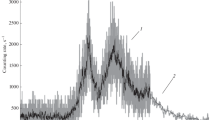Abstract
SKYLARK 723, launched at 1030 GMT on June 12, 1968, was an unstabilized rocket carrying two proportional counter detectors, each of 1,385 cm2 effective area. Detector C1 covered the energy range 1.4 to 2.5 keV and detector C2 the range 2.0 to 18 keV, analysed into four and nine energy channels respectively. The field of view of each detector was 28° by 4° (FWHM) with the greater collimator extension mounted parallel to the longitudinal rocket axis for C2 and six-tenths of the C1 detector, the remaining four-tenths of the C1 collimator being canted at 40° to the major axis. During the flight, the rocket spun at a constant rate of 75° s−1 while the spin axis slowly precessed about a flat cone, thereby surveying some 80 per cent of the visible sky. On twenty-five consecutive scans the Vir XR-1 source, which by chance lay near the precession axis, crossed the field of view of both detectors. The count rate profiles for twenty scans, in which the source passed within 21° of the centre of the field of view, have been added together for each detector, resulting in the totals shown in Fig. 1. Significant peaks are seen in the position of Vir XR-1 for both detectors and these have been fitted with the measured transmission profiles of the respective collimators assuming parallel incident radiation. The peaks are consistent with the observation of X-rays from a single “point source”. (The method of addition will tend to smooth out count-rate peaks for any sources away from the Virgo region, but separate examination of the data has shown only one other discrete X-ray source in the high latitude sweep covered by the data of Fig. 1. This is a weak source in Crater which gives rise to some excess counts to the left of the Virgo peak in Fig. 1, particularly on the C1 trace. The Crater observation will be reported separately.)
Similar content being viewed by others
References
Bradt, H., Mayer, W., Naranan, S., Rappaport, S., and Spada, G., Astrophys. J., 150, L199 (1967).
Byram, E. T., Chubb, T. A., and Friedman, H., Science, 152, 66 (1966).
Friedman, H., and Byram, E. T., Science, 158, 257 (1967).
Shklovskii, I. S., Sov. Astr., 11, 45 (1967).
Shklovskii, I. S., Sov. Phys.—Uspekhi, 5, 365 (1962).
Felten, J. E., Astrophys. J., 151, 861 (1968).
Felten, J. E., Arp, H. C., and Lynds, C. R., Contr. Kitt Peak Nat. Obs., No. 390 (1969).
De Vaucouleurs, G., Angione, R., and Fraser, C. W., Astrophys. Lett., 2, 141 (1968).
Burbidge, G. R., and Hoyle, F., Nature, 221, 847 (1969).
Burbidge, G. R., Nature, 216, 1287 (1967).
Author information
Authors and Affiliations
Rights and permissions
About this article
Cite this article
ADAMS, D., COOKE, B., EVANS, K. et al. Rocket Observations of Virgo XR-1. Nature 222, 757–759 (1969). https://doi.org/10.1038/222757b0
Received:
Issue Date:
DOI: https://doi.org/10.1038/222757b0
- Springer Nature Limited
This article is cited by
-
Cosmic X-ray spectra
Space Science Reviews (1972)
-
Recent Developments in X-ray Astronomy
Nature (1971)
-
Variability of X-ray Emission from M87
Nature (1971)
-
Variability in the X-ray Flux from M87
Nature Physical Science (1971)





